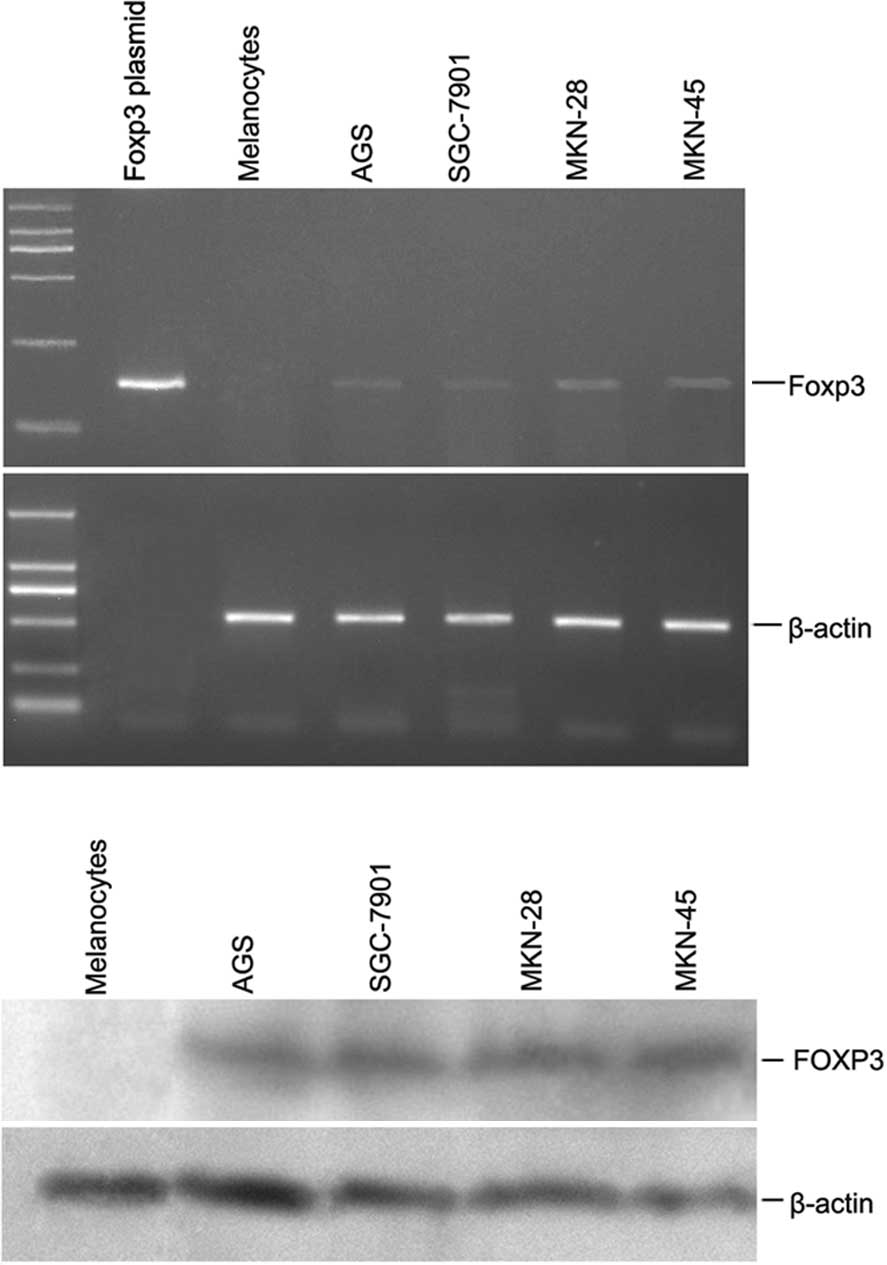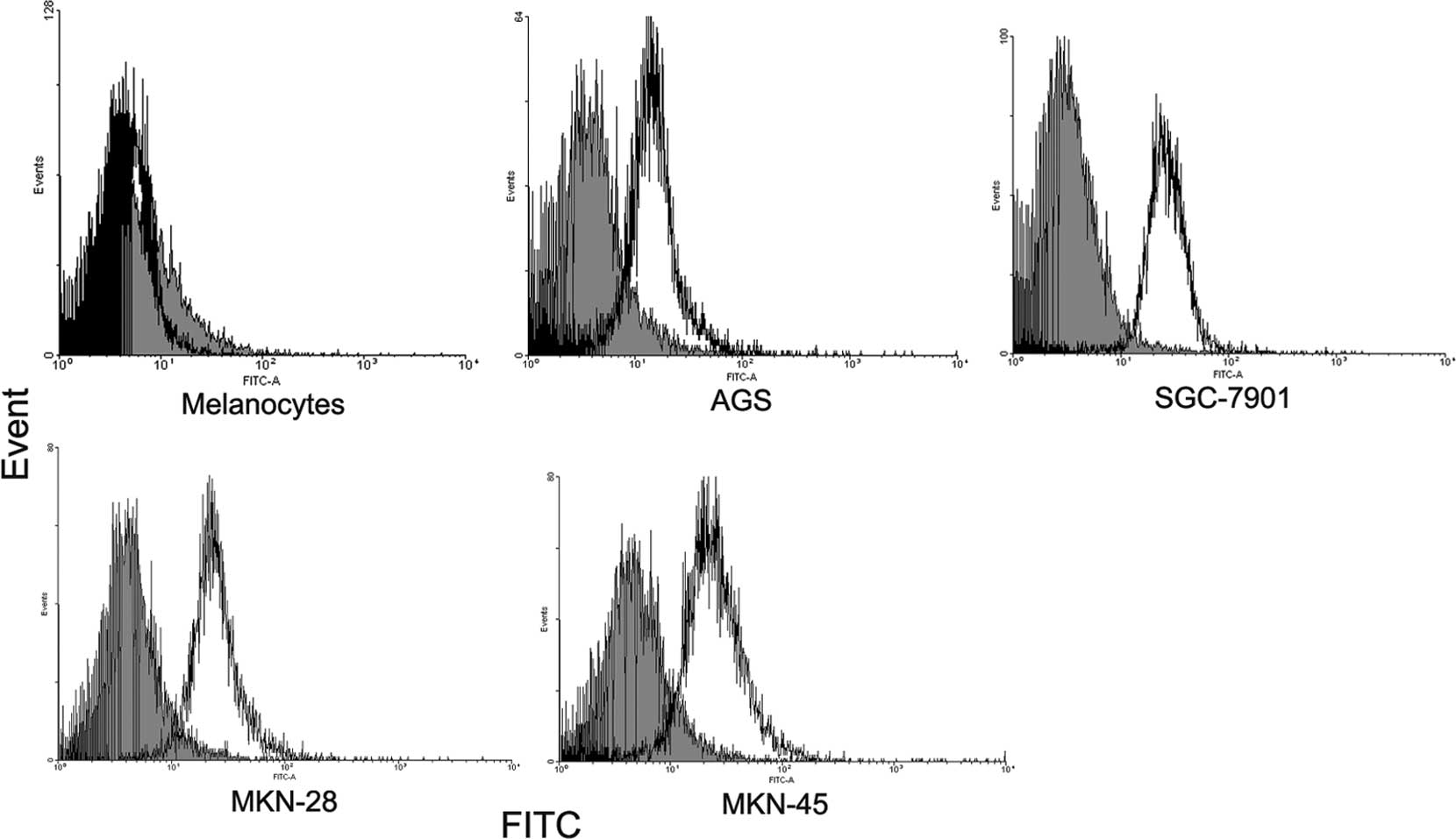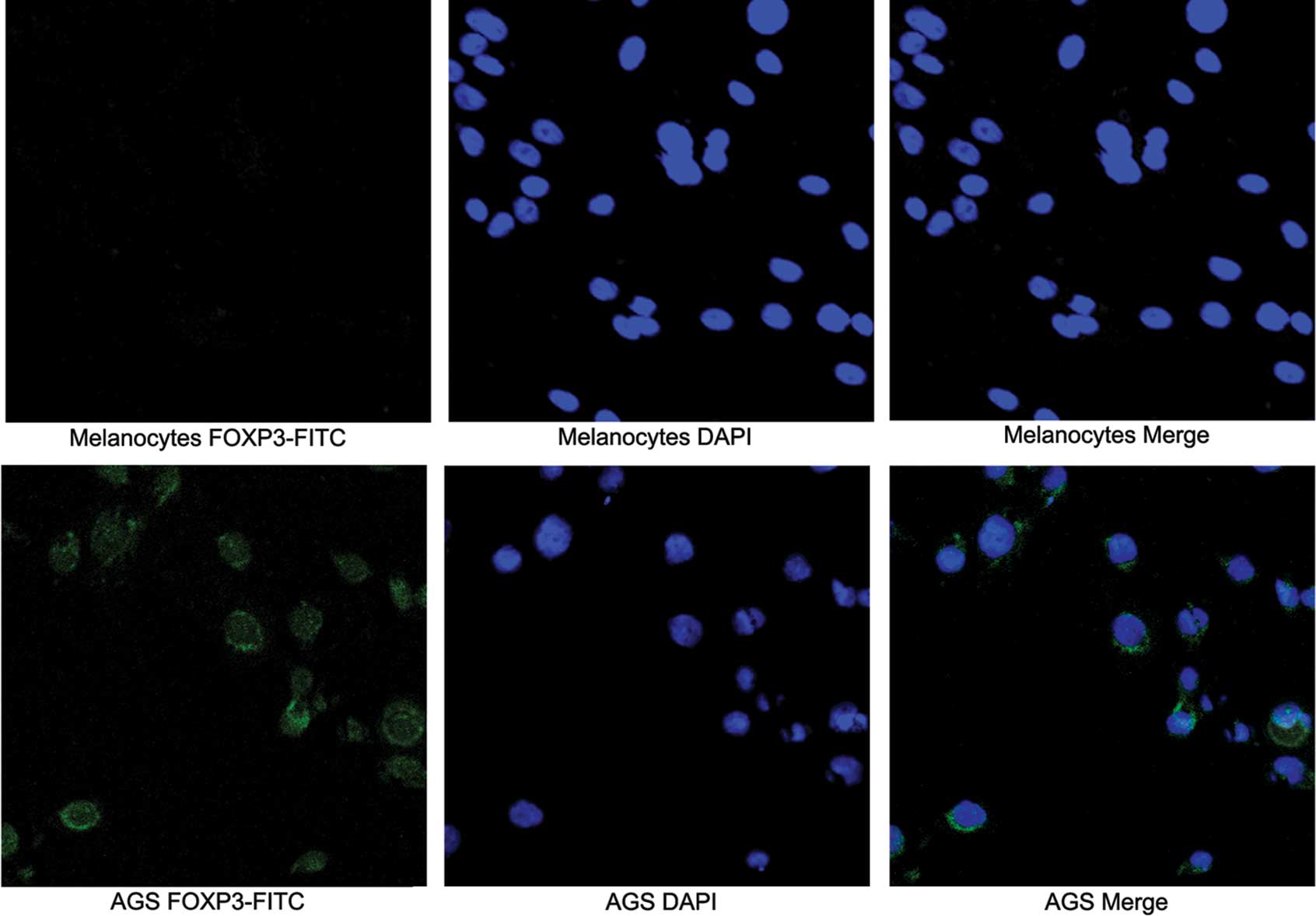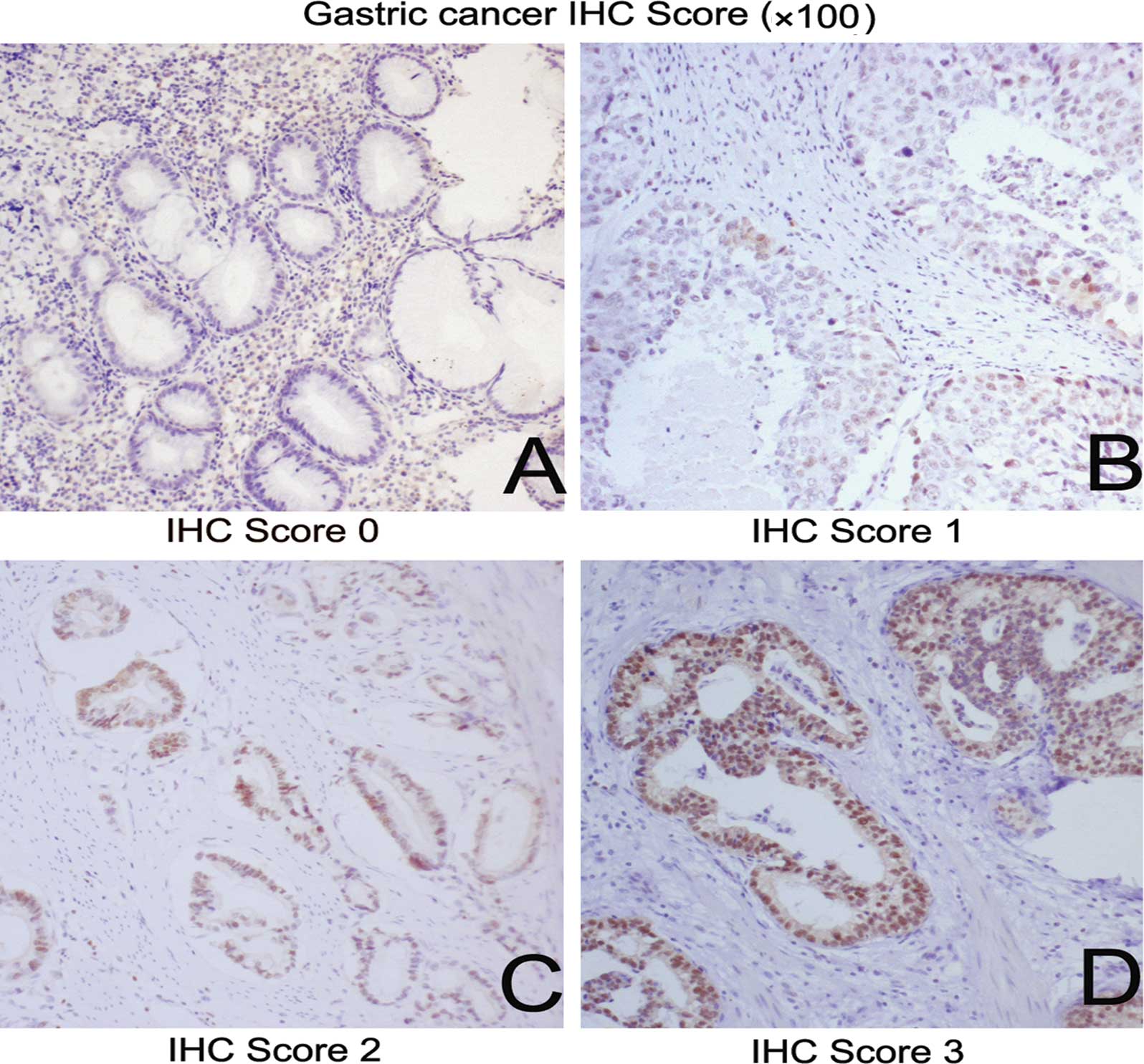Clinical implications and characteristics of factor forkhead box protein 3 in gastric cancer
- Authors:
- Published online on: May 12, 2011 https://doi.org/10.3892/etm.2011.264
- Pages: 667-673
Abstract
Introduction
Gastric cancer is the second most common cause of cancer-related death in the world (1). Gastric cancer is difficult to cure, mainly because most patients present with advanced disease at diagnosis. Patients with gastric cancer conventionally exhibit a poorly functioning immune system, such as decreased T-cell proliferation, a low CD4+/CD8+ ratio and a deficient production of T-helper cytokines (2–4). This condition of poor response does not improve significantly after surgery (5).
Gastric adenocarcinoma often begins at a site where the stomach lining is inflamed. Numerous experts believe that an infection with the bacterium Helicobacter pylori is the cause of most stomach cancers (6–8). It has been reported that H. pylori-infected individuals have increased levels of regulatory T cells (Tregs) in the gastric and duodenal mucosa that express factor forkhead box protein 3 (foxp3) mRNA. The induction of the Treg response contributes to an equilibrium between the host and the bacterium, allowing H. pylori to survive, while also preventing the risk of destructive inflammation (9). These reports suggest that FOXP3 expression may play an important role in gastric cancer development.
FOXP3 is a member of the forkhead/winged-helix family of transcriptional regulators and is considered to be an important gene which functions as a regulator of thymically derived naturally occurring regulatory T cells (nTregs) (10). Furthermore, transfection of Foxp3 allows CD4+ FOXP3− human T cells to acquire many characteristics of Tregs (11,12). Various studies have found the expression of FOXP3 in pancreatic carcinoma cells, melanoma cells, hepatocellular carcinoma and other types of tumor cells (13–15). They demonstrated not only the existing function, but various immune functions of FOXP3 in a few types of cancers. They described that the expression of FOXP3 has some influence on the production of IL-10 and TGF-β2. These cytokines are well known for playing immune inhibition roles in tumor development and escape. Although there are contradictions concerning the functions of FOXP3 in different types of tumors, these results suggest another important biological characteristic of FOXP3 in cancer genesis and development. According to these findings, we hypothesized that FOXP3 expression is related to gastric cancer.
In the present study, the expression and localization of FOXP3 were identified in gastric cancer cell lines and tissues. The distribution of FOXP3 in human gastric cancer patients was evaluated and the relationship was analyzed between these findings and grades of tumor differentiation.
Materials and methods
Source of normal and cancerous gastric tissue sections and tissue array
Normal and cancerous gastric tissues were obtained from patients (normal, 16; gastric cancer, 39 including 31 males and 8 females, 31–78 years of age) who underwent partial gastrectomy or gastric biopsy. Normal controls were histologically normal tissues and were obtained from patients who underwent partial gastrectomy for metastatic tumor or gastric biopsy. Microarray tissues (normal 16; gastric cancer, 71 including 54 males and 17 females, 31–71 years of age) were obtained from Cybrdi, USA. The study protocol conformed to the ethical guidelines of the 1975 Declaration of Helsinki and received prior approval by the Fourth Military Medical University, China.
Cell culture
Complete medium (RPMI-1640) contained RPMI-1640 supplemented with 2 mmol/l Glutamax, 100 U/ ml penicillin, 100 μg/ml streptomycin and 10 mmol/l HEPES (Invitrogen, USA) and 10% FCS (Thermo Trace, Australia). The following additional cell lines were obtained from the Biotechnology Center of the Fourth Military Medical University: AGS, SGC-7901, MKN-28 and MKN-45. All tumor cell lines were maintained in complete RPMI-1640 and passaged using trypsin/EDTA (Invitrogen). Melanocytes were freshly prepared when used (derived from normal human skins, from the Department of Dermatology, Xijing Hospital, the Fourth Military Medical University, China).
Semi-quantitative and reverse-transcription PCR
Total RNA was isolated from gastric cancer cells and melanocytes (as control) using TRIzol reagent (Invitrogen). A total of 500 ng of total RNA was reverse transcribed using the kit from Takara, Japan. PCR was performed for the Foxp3 fragment amplification. The following primers were used (5′-3′): Foxp3 sense: CACAACATGCGACCCCCTTTCACC; Foxp3 antisense: AGGTTGTGGCGGATGGCGTTCTTC. β-actin was used as an internal control for normalization (primer sequences available on request). Semi-quantitative RT-PCR of FOXP3 transcripts was carried out by comparing the signal intensities of PCR products of Foxp3 gene to that of the β-actin gene from the same RNA sample using agarose gel electrophoresis. The intensities of the product bands were quantified by densitometric scanning of the gels (Pharmacia Biotech) using ‘Total Image’ 1D GEL Analysis software. DNA marker (Takara) was run in each gel to confirm the size of the PCR product.
Western blot analysis
To examine the protein expression level of FOXP3 in gastric cancer cells, whole cell lysates were subjected to SDS-PAGE electrophoresis, followed by blotting on a nitrocellulose membrane. For FOXP3 detection, membranes were probed with goat anti-human FOXP3 polyclonal antibody overnight at 4°C followed by incubation with a secondary horseradish peroxidase-conjugated antibody. The mouse anti-human β-actin monoclonal antibody was used as an internal control (R&D, USA). Chemiluminescent detection was performed with the enhanced chemiluminescence detection kit (Anmei, China).
Flow cytometry
To determine the expression of FOXP3, gastric cancer cells were stained for FOXP3 and analyzed by flow cytometry. Cells were washed in PBS containing 1% bovine serum albumin (BSA) and 0.1% NaN3 before antibody staining, followed by fixation with 1% paraformaldehyde. Fluorescein isothiocyanate (FITC)-conjugated rat anti-human FOXP3 monoclonal antibody was purchased from eBiosciences, USA. A total of 105 events were collected using Becton Dickinson FACScaliber (Becton Dickinson, USA). Analysis was performed using the WinMDI 2.8 program (Purdue University Cytometry Laboratories, USA).
Confocal microscopic analysis
For double-labeled immunofluorescence, formalin-fixed slides of the cell lines were treated in 3% hydrogen peroxide in methanol for 10 min. Following three rinses in PBS, the slides were treated for 1 h in blocking solution (Zhongshan, China). Slides were incubated for 1 h at room temperature with the FITC-conjugated rat anti-human FOXP3 monoclonal antibody (eBioscience, USA) diluted in 1% bovine serum albumin in TBS with 0.1% Tween-20. Following PBS rinsing, the slides were treated with a 1:1,000 dilution of diamidino-phenylindole (DAPI) (stock solution 1 mg/ml) (Sigma-Aldrich, USA) for 30 min which was used to visualize nuclei. The slides were mounted with the Prolong Anti-Fade mounting medium. Slides were examined with a Leica TCS-SP laser scanning confocal microscope (Leica, German). All images were collected using a pinhole of 1 Airy unit.
Immunohistochemistry
This study was approved by the Department of Pathology, Xijing Hospital, the Fourth Military Medical University, China. Paraffin-embedded resected gastric cancer specimens (n=55) from 2006 through 2008 were retrieved from the Xijing Hospital tissue bank. Rat anti-human FOXP3 monoclonal antibody was applied to paraffin-embedded sections after microwave antigen retrieval for 10 min in 0.01 mol/l citrate buffer (pH 6.0). Specimens were treated with 0.3% hydrogen peroxide in methanol for 15 min after incubation with the primary antibody to block endogenous peroxidase activity and blocked with human serum to minimize background reactivity. The secondary antibody of horseradish peroxidase-labeled goat anti-rat antibody (Zhongshan, China) was diluted with 10% human serum and incubated for 1 h. These slides were examined systematically using an image analyzer system (Olympus BH-2 microscope; Japan).
Semi-quantitative analysis of immunohistochemistry
Slides were reviewed under light microscopy at x100 magnification by two pathologists separately. Semi-quantitative analysis of FOXP3 staining was assessed as 0, 1+, 2+ and 3+ as previously established (16,17). Grade 0 was defined as the complete absence or weak FOXP3 immunostaining in <1% of tumor cells; grade 1+ was focal positivity in 1–10% of tumor cells; grade 2+ was positive FOXP3 immunostaining in 11–50% of tumor cells; and grade 3+ was positive FOXP3 immunostaining in >50% of tumor cells. A global assessment of the entire tumor was carried out without selection for the invasive front or areas of active tumor growth. The frequency and semi-quantitative analysis of positive tumors for all regions were calculated for statistical comparisons.
Statistical analysis
Differences in proportions were compared using the Pearson Chi-square test or Fisher’s Exact test, as appropriate. The statistic correlations between the grades of gastric cancer differentiation and the staining level of FOXP3 were analyzed using the Cochran-Mantel-Haenszel test. Differences with a P-value <0.05 were considered to be statistically significant. All analyses were carried out using SAS statistical software version 9.1 (Cary, NC, USA).
Results
FOXP3 is widely expressed in gastric cancer cell lines
In an initial analysis of RT-PCR, Foxp3 was found in several gastric cell lines. To further validate these results, semi-quantitative RT-PCR analysis of the four gastric cancer cell lines and melanocytes was conducted. The results revealed a significant overexpression of Foxp3 in the gastric cancer specimens compared to the non-malignant melanocytes (Fig. 1A). The cell lines shown in Fig. 1A (AGS, SGC-7901, MKN-28 and MKN-45) were uniformly positive for Foxp3. Staining of melanocytes was negative, as expected. Foxp3 full length plasmid was conducted and kept by us (data not shown).
Moreover, as shown in Fig. 1B, FOXP3 protein was detected in the gastric cancer cell lines by Western blotting. Since FOXP3 expression in the gastric cancer cells was a novel observation, we confirmed the staining results in the Western blotting using two different anti-FOXP3 antibodies (eBioscience and R&D; data not shown). Thus, FOXP3 was widely expressed in the gastric cancer cell lines (but not in the normal melanocytes); however, the intensity of expression was variable.
FOXP3 localization in the gastric cancer cell lines
Staining with anti-FOXP3 resulted in a shift in the fluorescence of the entire population compared to the isotype control. By contrast, melanocytes did not express detectable FOXP3 (Fig. 2). Subcellular distribution of FOXP3 expression by confocal microscopy was used to examine the distribution of FOXP3 in gastric cancer cell lines and melanocytes. In these experiments, the nuclei were stained with DAPI to facilitate analysis. Tumor cells exhibiting intense nuclear and less intense cytoplasmic expression were observed in the AGS cell line (Fig. 3).
FOXP3 expression in gastric cancer tissues
Immunohistochemistry was used to analyze the protein expression of FOXP3 in the gastric cancer specimens. Staining was carried out on a set of 39 tissue sections (Table I) and on a tissue array containing 71 cores (Table II) from normal and cancerous gastric tissues representing gastric cancer of all differentiation grades. Twenty-two of 39 (56.4%) tissue sections displayed nuclear FOXP3 staining. Of these, 3 tissue samples exhibited nuclear and cytoplasmic staining. Similarly, in the tissue array, FOXP3 nuclear staining was observed in ∼28 of the 71 (39.4%) cores (Table II). Nine tissues exhibited nuclear and cytoplasmic staining. Thus, FOXP3 was expressed in the vast majority of specimens.
Table I.Association of FOXP3 with clinicopathological grades and staining intensity in 39 gastric cancer in tissue sections. |
Table II.Association of FOXP3 with clinicopathological grades and staining intensity in 71 gastric cancer tissue arrays. |
Notably, FOXP3 localized to the nucleus of most gastric cancer cells in both the tissue sections and the tissue array. To confirm the validity of the observed nuclear staining, two different anti-human FOXP3-specific antibodies were used. Both antibodies provided similar patterns (data not shown), thus validating our observation of nuclear FOXP3 localization in gastric cancer tissues.
FOXP3 is associated with poorly differentiated cancer and a high frequency of low intensity staining
The effect of FOXP3 on overall cases for histopathological grade was examined. Notably, many poorly differentiated cancerous cases were FOXP3-positive, and the intensity of FOXP3 staining was low. These results, however, were statistically significant in the tissue array, but not in the tumor sections, potentially due to the small sample size of tumor sections. The proportion of stained cells was significantly different among the histopathological grades in the tissue array. Of the 28 positive cancer cores in the tissue array, 11 of 37 (30%) grade I, 6 of 21 (29%) grade II and 11 of 13 (85%) grade III carcinoma cores (Fig. 4) were positive for FOXP3 (P=0.0011, Pearson’s Chi-square test; Table II). This suggests that a high frequency of nuclear FOXP3 may be a positive prognostic factor in patients with poorly differentiated tumor tissues.
FOXP3 was detected in 28 of the 71 (39.4%) specimens of the tissue array. Semi-quantitative staining was scored as 1+ in 17 (60.7%), 2+ in 8 (28.6%) and 3+ in 3 (10.7%) cases (examples provided in Table II and Fig. 5). The staining scores varied considerably between the subgroups. A significantly higher frequency of low FOXP3 expression was noted in the poorly differentiated gastric cancer tissues (Table II). As shown in Table II, a considerable linear trend of gastric cancer differentiation was observed across FOXP3 staining scores (nonzero correlation 4.86, P=0.003; general association 15.41, P=0.02; departure from linear regression 10.55, 0.1<P<0.05). Moreover, we found that FOXP3 was frequently expressed in adenocarcinoma, while only seldom expressed in mucinous cancers and signet-ring carcinomas. However, there were fewer samples. The normal gastric tissues were also devoid of FOXP3 expression. In all patients, tumor-infiltrating lymphocytes were FOXP3-positive (Fig. 5).
Discussion
Although the factors and molecular events associated with the progression of gastric cancer are complex and are not well established, FOXP3 has been shown to play an important role in Tregs in gastric cancer invasion (18). In this study, we assessed the expression and subcellular localization of FOXP3 in gastric cancer cell lines and tissues. At the same time, we also identified the relationship between the expression level of FOXP3 and tumor differentiation grade.
Others researchers have previously noted nuclear and cytoplasm localization of FOXP3 in pancreatic carcinoma, melanoma and colon carcinoma cells by immunohistochemistry. In agreement with previously published studies, expression of Foxp3 mRNA was also revealed in various gastric cancer cell lines studied. Relative expression values for tumor cells varied widely and were significantly higher than those of melanocytes. At the same time, we observed a higher frequency of expression of FOXP3 in the whole-cell extracts of the gastric cancer cell lines (AGS, SGC-7901, MKN-28 and MKN-45) compared to the melanocytes. Upon analysis, we found that nuclear, and to a lesser extent, cytoplasmic FOXP3 expression was more prevalent in the gastric cancer cell lines. This observation may suggest a relationship between expression and localization of FOXP3. To our knowledge, this study provides the first evidence of nuclear and cytoplasmic localization of FOXP3 in gastric cancer cell lines.
Notably, we found that gastric cancer cell lines expressed FOXP3 mainly in the nucleus and cytoplasm, but in gastric cancer tissues FOXP3 was mostly expressed in the nucleus. This suggests that the microenvironment of tumors (such as cytokines, immune cells, ligands and receptors of tumor cells) may induce a change in the subcellular localization of FOXP3 from a cytoplasmic to a nuclear expression pattern, which may result from post-translational modifications (19). Therefore, the heterogeneous subcellular localization of FOXP3 in gastric cancer cell lines and tissues may reflect the presence of different post-translationally modified forms of FOXP3. The functional relevance of this finding requires further investigation. In particular, previous reports have revealed the interaction of FOXP3 with the nuclear factor of activated T cells, suggesting that FOXP3 plays an important role in the formation of nuclear complexes that are important in the regulation of the transcription of functional genes, that confer a suppressive function to Tregs (20,21).
In tissue sections, nuclear FOXP3 was not present in normal and para-tumor tissues. This observation was also confirmed in the tissue array cores and was statistically significant (P= 0.0011), indicating that nuclear FOXP3 may play a role in gastric cancer progression. Our statistical results revealed a linear relationship between an increase in the worsening of differentiation of gastric cancer tissues and intensity of FOXP3 expression. High frequency and intensity of staining of nuclear FOXP3 expression may aid in the identification of gastric cancer of poorly differentiated tumor potential. However, the results showed no correlation between FOXP3 expression and gender or age, in the tissue sections and array (Tables I and II).
Five prior studies assessing FOXP3 in tissues and cell lines have been reported. Hinz et al described for the first time the expression and function of FOXP3 in pancreatic ductal adenocarcinoma cells and tumors (13). They detected FOXP3 expression in tumor cells of 24 out of 39 patients with pancreatic carcinoma. Although they were unable to find a correlation between FOXP3 expression or subcellular localization and tumor stage or survival, their findings indicate that pancreatic carcinoma cells share growth suppressive effects with Tregs and suggest that mimicking Treg function may represent a new mechanism of immune evasion in pancreatic cancer. Ebert et al and Karanikas et al also found that FOXP3 transcription factor was expressed in melanoma and numerous types of tumor cells (14,15). Evidence suggests that FOXP3 is related to tumor escape and could be used as a potential tumor antigen. On the contrary, Zou et al reported that functional somatic mutations and down-regulation of the Foxp3 gene were commonly found in human breast cancer samples. This also correlated with HER-2/ ErbB2 and SKP-2 overexpression (22,23). Whether the presence of mutations could account for the low expression levels of FOXP3 in breast tumor cell lines remains to be investigated.
The statistical significance in the tissue sections and the tissue array was similar, but the positive ratios of FOXP3 were different (tissue sections 56.4%; tissue microarray 39.4%). During observation, we found that the expression of FOXP3 was mostly focal in the tissue sections. Results of the FOXP3 immunohistochemistry intensity score system revealed that 62–78% of the poorly differentiated cancer samples focally expressed FOXP3. Therefore, we conclude that the discrepancy may be due to the small square of tissue cores of the array, which could not include focal expression of FOXP3. Although the percentages of FOXP3-positive staining were different in the tissue sections and array, the quantity of tissue array was sufficient to obtain significant differences among the groups by statistical analysis.
The two principal findings of our study reveal that FOXP3 is widely expressed in gastric cancer and a high intensity and frequency is a prognostic marker in poorly differentiated gastric cancer. This suggests the possibility that the intensity of FOXP3 expression in poorly differentiated gastric cancer patients may predict a worse prognosis and can be further studied to determine its usefulness in guiding immune therapy strategies.
In conclusion, this is the first report of nuclear localization of FOXP3 in gastric cancer cell lines and tissues. This indicates that FOXP3 is widely expressed in tumor cells and tissues. Although FOXP3 has been found to play an important role during development and differentiation of Tregs, the molecular mechanisms of FOXP3 and its function in cancer are yet unknown. The inhibitory character of FOXP3 in Tregs has been demonstrated. Further research is needed to determine whether FOXP3 plays an inhibitory role in cancers. In addition, the correlation of nuclear FOXP3 expression with tumor grade in gastric cancer tissues warrants further study in order to understand the critical molecular events associated with gastric cancer progression.
Acknowledgements
The authors thank Dr Lieping Chen and Dr Yili Yang for the helpful comments and suggestions on the manuscript, and the members of the Department of Pathology of Xijing Hospital of Fourth Military Medical University for the excellent technical support. This study was supported by the program for Changjiang Scholars and Innovative Research Team in University (PCSIRT) in China.
References
|
Crew KD and Neugut AI: Epidemiology of gastric cancer. World J Gastroenterol. 12:354–362. 2006. | |
|
Wolf AM, Wolf D, Steurer M, Gastl G, Gunsilius E and Grubeck-Loebenstein B: Increase of regulatory T cells in the peripheral blood of cancer patients. Clin Cancer Res. 9:606–612. 2003.PubMed/NCBI | |
|
McMillan DC, Fyffe GD, Wotherspoon HA, Cooke TG and McArdle CS: Prospective study of circulating T-lymphocyte subpopulations and disease progression in colorectal cancer. Dis Colon Rectum. 40:1068–1071. 1997. View Article : Google Scholar : PubMed/NCBI | |
|
Santos LB, Yamada FT and Scheinberg MA: Monocyte and lymphocyte interaction in patients with advanced cancer. Evidence for deficient IL-1 production. Cancer. 56:1553–1558. 1985. View Article : Google Scholar : PubMed/NCBI | |
|
Barbieri C, Fujisawa MM, Yasuda CL, et al: Effect of surgical treatment on the cellular immune response of gastric cancer patients. Braz J Med Biol Res. 36:339–345. 2003. View Article : Google Scholar : PubMed/NCBI | |
|
Parsonnet J, Hansen S, Rodriguez L, et al: Helicobacter pylori infection and gastric lymphoma. N Engl J Med. 330:1267–1271. 1994. View Article : Google Scholar : PubMed/NCBI | |
|
Ando T, Goto Y, Maeda O, Watanabe O, Ishiguro K and Goto H: Causal role of Helicobacter pylori infection in gastric cancer. World J Gastroenterol. 12:181–186. 2006. | |
|
Aromaa A, Kosunen TU, Knekt P, et al: Circulating anti-Helicobacter pylori immunoglobulin A antibodies and low serum pepsinogen I level are associated with increased risk of gastric cancer. Am J Epidemiol. 144:142–149. 1996. | |
|
Rad R, Brenner L, Bauer S, et al: CD25+/Foxp3+ T cells regulate gastric inflammation and Helicobacter pylori colonization in vivo. Gastroenterology. 131:525–537. 2006. | |
|
Hori S and Sakaguchi S: Foxp3: a critical regulator of the development and function of regulatory T cells. Microbes Infect. 6:745–751. 2004. View Article : Google Scholar : PubMed/NCBI | |
|
Yagi H, Nomura T, Nakamura K, et al: Crucial role of FOXP3 in the development and function of human CD25+CD4+ regulatory T cells. Int Immunol. 16:1643–1656. 2004. View Article : Google Scholar : PubMed/NCBI | |
|
Allan SE, Passerini L, Bacchetta R, et al: The role of 2 FOXP3 isoforms in the generation of human CD4+ Tregs. J Clin Invest. 115:3276–3284. 2005. View Article : Google Scholar : PubMed/NCBI | |
|
Hinz S, Pagerols-Raluy L, Oberg HH, et al: Foxp3 expression in pancreatic carcinoma cells as a novel mechanism of immune evasion in cancer. Cancer Res. 67:8344–8350. 2007. View Article : Google Scholar : PubMed/NCBI | |
|
Ebert LM, Tan BS, Browning J, et al: The regulatory T cell-associated transcription factor FoxP3 is expressed by tumor cells. Cancer Res. 68:3001–3009. 2008. View Article : Google Scholar : PubMed/NCBI | |
|
Karanikas V, Speletas M, Zamanakou M, et al: Foxp3 expression in human cancer cells. J Transl Med. 6:192008. View Article : Google Scholar : PubMed/NCBI | |
|
Iwasa S, Jin X, Okada K, Mitsumata M and Ooi A: Increased expression of seprase, a membrane-type serine protease, is associated with lymph node metastasis in human colorectal cancer. Cancer Lett. 199:91–98. 2003. View Article : Google Scholar : PubMed/NCBI | |
|
Ariga N, Sato E, Ohuchi N, Nagura H and Ohtani H: Stromal expression of fibroblast activation protein/seprase, a cell membrane serine proteinase and gelatinase, is associated with longer survival in patients with invasive ductal carcinoma of breast. Int J Cancer. 95:67–72. 2001. View Article : Google Scholar | |
|
Lundgren A, Stromberg E, Sjoling A, et al: Mucosal FOXP3-expressing CD4+ CD25high regulatory T cells in Helicobacter pylori-infected patients. Infect Immun. 73:523–531. 2005.PubMed/NCBI | |
|
Chen C, Rowell EA, Thomas RM, Hancock WW and Wells AD: Transcriptional regulation by Foxp3 is associated with direct promoter occupancy and modulation of histone acetylation. J Biol Chem. 281:36828–36834. 2006. View Article : Google Scholar : PubMed/NCBI | |
|
Marson A, Kretschmer K, Frampton GM, et al: Foxp3 occupancy and regulation of key target genes during T-cell stimulation. Nature. 445:931–935. 2007. View Article : Google Scholar : PubMed/NCBI | |
|
Wu Y, Borde M, Heissmeyer V, et al: FOXP3 controls regulatory T cell function through cooperation with NFAT. Cell. 126:375–387. 2006. View Article : Google Scholar : PubMed/NCBI | |
|
Zuo T, Wang L, Morrison C, et al: FOXP3 is an X-linked breast cancer suppressor gene and an important repressor of the HER-2/ErbB2 oncogene. Cell. 129:1275–1286. 2007. View Article : Google Scholar : PubMed/NCBI | |
|
Zuo T, Liu R, Zhang H, et al: FOXP3 is a novel transcriptional repressor for the breast cancer oncogene SKP2. J Clin Invest. 117:3765–3773. 2007.PubMed/NCBI |














